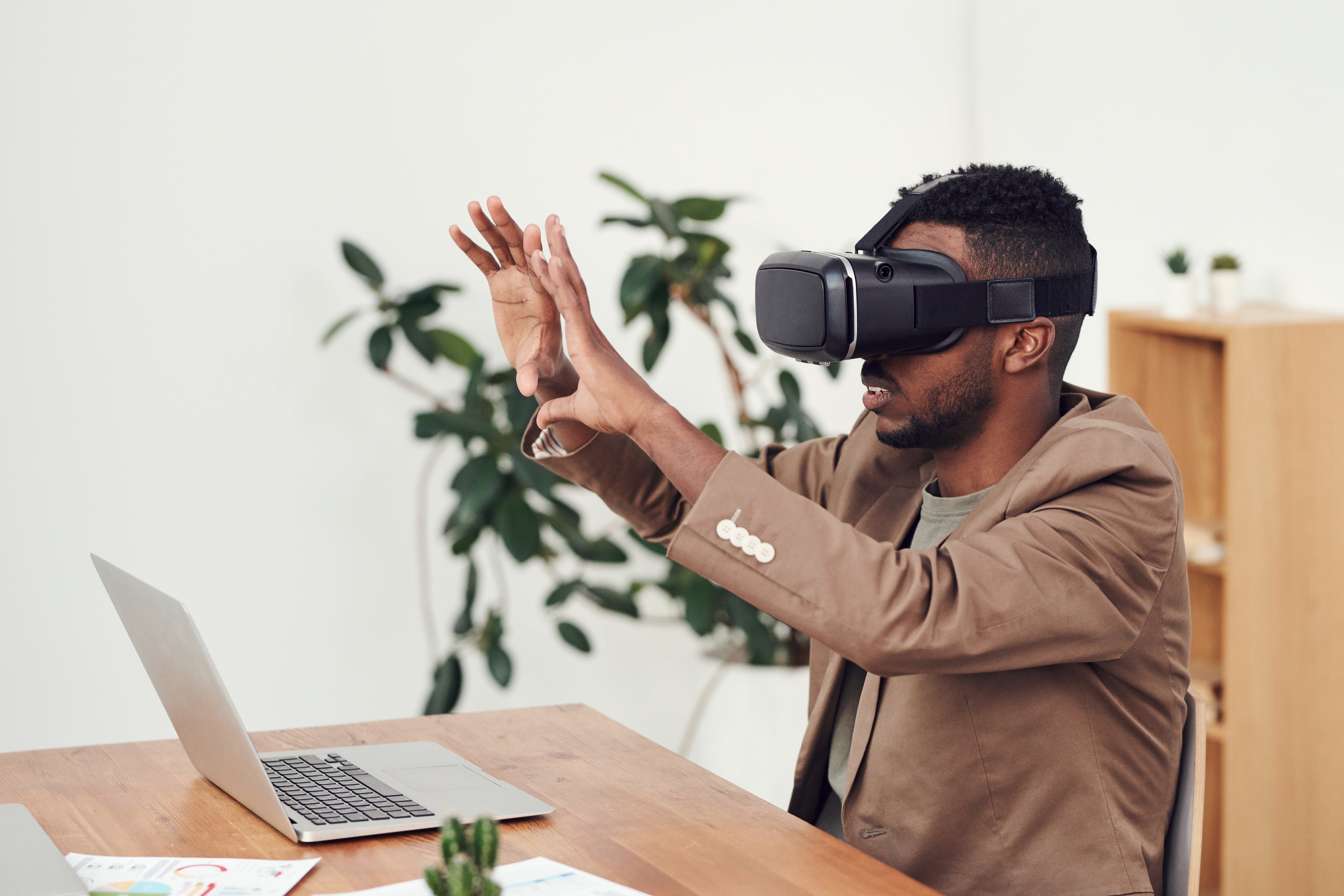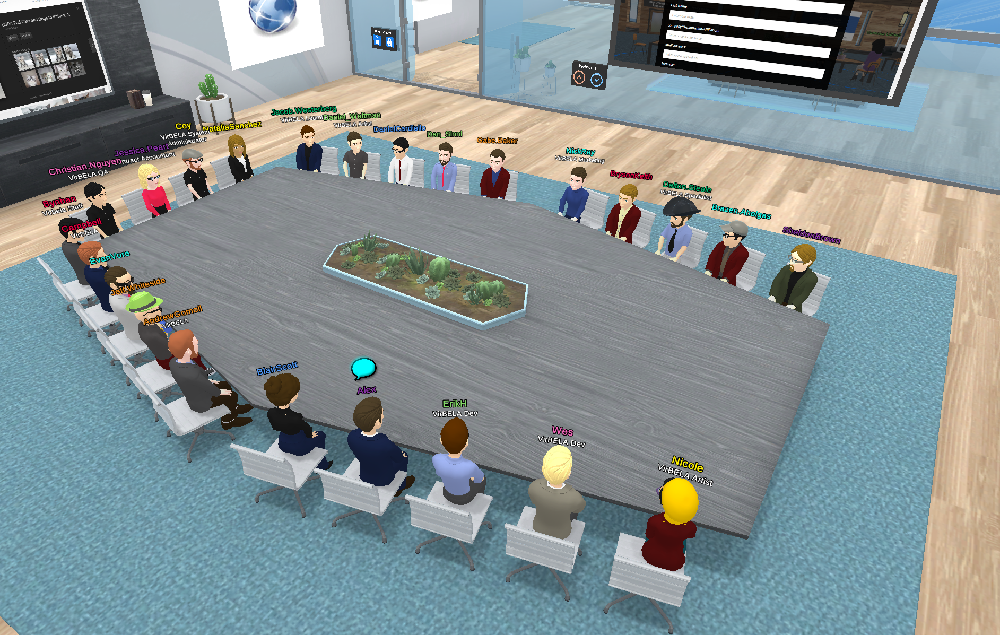
Crédits photos : Fauxels (Pexels)
Over the past few weeks, we have been witnessing a radical transformation in global activity. Confined to their homes, millions of workers are working at home to continue their professional missions to the best of their ability. Many remote working tools already exist and are coming out of the shadows. How is the current context going to accelerate our appropriation of new technologies and make them essential to our working methods in the future?
The majority of distance working tools offer places and interactions adapted to different uses: exchanges of ideas, files, 3D models, training, experimentation, tool handling. Immersion and interactivity in meetings are effective solutions for working with teams and colleagues at a distance, but not only. How do virtualization and virtual tools have a place in the future of work?
Virtual work meetings for more remote presence
At a time when trends in corporate office design are bringing workers together as often as possible to promote “team building”, extended remote working may be more difficult than it seems. Organisation and concentration are not the same, neither is our social life. The excessive use of screens and telephones eventually causes us to lose some of the feelings we had when we were physically present alongside our colleagues. How can we keep this social cohesion at a distance? With more presence in remote experiences, as enabled by immersive technologies.
Meetings between colleagues over coffee are still going on at the moment. Except that everyone is at home, in front of his or her computer screen, camera and microphone switched on. With the confinement, the worker has to adapt. Online meetings are the most natural choice. Immersive technologies offer a wider world in which we feel more present than in front of the video call. Virtual reality meeting rooms offer additional functionalities that make it easier to work remotely when there are several employees. We have selected two examples of online collaboration tools for working remotely and feeling like you are in the same place.
For example, MeetingRoom, a virtual meeting room that provides collaboration and presentation tools (tables, post-its, slide shows). These tools enable 12 employees to meet simultaneously in a virtual environment. Inside, each user can not only see the others, but also talk, listen, and participate by writing, modifying and reorganising the content presented. MeetingRoom offers meeting rooms with a standard model. But it is also possible to customise the design, in particular to embellish it with the company’s graphic charter. The presentation tools allow for project management meetings, as well as customer presentations. It is a first basic tool that allows simple collaboration between colleagues or with external collaborators.
Another example is the Glue Collaboration platform. Glue is a “virtual extension of your work environment, a space where dispersed teams come together to learn, share, plan and create.” This platform promises and ensures a real presence. Users can interact with others remotely as if they were face-to-face. In addition, when someone speaks in the virtual world, their avatar makes gestures of arms, hands, etc., and the user can interact with others remotely as if they were face to face. Glue is above all a space for real-time collaboration. Its ambition is to offer employees a way to work and collaborate “in a more human, productive and sustainable way”.
These are just two of many examples. The biggest advantage of virtual reality for meetings is without a doubt the feeling of presence that we feel and also the manipulation of 3D objects in real time.
Collaborative virtual workspaces for long-distance design
Virtual reality meetings involve participants more in the collaboration than video meetings. Collaborative design, joint manipulation of 3D objects open up further presentation possibilities. In some trades, it is already becoming an indispensable tool.
Take architecture for example. An online meeting does not allow you to work on a project in a complete way. Indeed, the architect, the project manager and the client need to visualise the architectural project. It is difficult to communicate an idea in writing or even orally. What could be better than a collaborative tool to design a project with several people in real time?
Conceived in the United States, The Wild is an example of a remote collaboration platform for designing environments. It is specially adapted for the architecture sector. Indeed, it allows you to project yourself into an VR construction project. It is possible to import a 3D model (called BIM 360) into the platform. The user can then either view it at a reduced size or teleport to view it at scale 1. While inside the architectural building, he can observe, move around, but also add comments and draw in the experience. These last two features are ideal for collaborating with other partners on a design project. Modifications and suggestions can be made in real time, so that all collaborators can see it. This saves a lot of time and simplifies remote communication.
Similar to The Wild, there is also Insite VR, described as immersive communication software for architecture. Thanks to this tool, collaborators can meet in a virtual environment to work together. In this digitally created world, collaborators can visualise a construction project in 3D. They then have the possibility to observe it but above all to interact with this model. Everyone can make live modifications and gather the opinions of their colleagues, or make annotations to point out design errors. The great advantage is therefore to be able to communicate and work live and at the same time. This saves a lot of time when you are at a distance.
The during and after: towards a change in our work habits?
Today’s confinement forces us to follow a new way of life and new working methods. Faced with the social distancing imposed on us all, we must find solutions to continue working and communicating effectively. The current situation forces us to adapt. In this context, virtual and online tools are coming out of the shadows. These platforms and software allow us to collaborate easily at a distance by organising virtual meetings, which strengthen our sense of presence, but also of belonging to a social group. This immersion in digital environments offers the possibility to work on projects in 3D. Advantages that you don’t get with online video software.
What about post-confinement? Will virtual tools still be relevant? After weeks of confinement, the time will certainly be right for a reunion. This period of crisis will have given rise to existing alternative solutions. And the end of confinement will not mean the end of the use of virtual tools, but will reorganise it. While on a local scale, physical meetings will resume, on an international scale, remote virtual meetings will continue.
A good example of a virtual world dedicated to companies: VirBELA. It is a virtual place to bring together physically distant people. For students, for example, it offers incredible potential. For example, Stanford University has used this platform to give distance learning courses. This represents additional training for students, allowing them to gain access to scientific knowledge that is not normally accessible. Compared to online MOOCs, MOOCs in virtual worlds help to maintain this sense of presence and promote networking.
Another example of training, this time vocational. Some medical equipment suppliers begin training health professionals in virtual reality even before the devices are delivered. To give an example, in England, the company Immerse provided its customer GE Healthcare with a virtual reality tool for training radiologists. Their work and skills are based on the use of CT scanners. Immerse has thus created a virtual examination room with a scanner for training and practice, to be operational before the scanner arrives in the health establishment.

Simply put, immersive technologies can bring a lot to the business world. But you have to know how to use them wisely. Virtual reality experiences can speed up certain stages of collaboration but do not allow you to stay in a conference for 8 hours. They are therefore complementary to other digital and connected solutions. They do not replace relationships or the need to be together, but appear to be a sustainable solution when thousands of kilometres separate us, in an ecological reflection to reduce travel.


